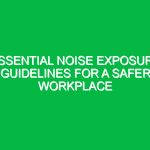Introduction
Hello everyone, and welcome to today’s Toolbox Talk. Today, we will discuss an essential aspect of our work—Surveying (Construction). This topic is crucial for ensuring that our construction projects are executed safely and efficiently. As you know, proper surveying is not just about measuring land; it plays a significant role in our Health, Safety, and Environment (HSE) practices. By the end of this talk, you should have a better understanding of effective surveying techniques, their importance, and how they can help us maintain a safe working environment.
The Importance of Surveying in HSE
Surveying (Construction) is the process of measuring and mapping the environment using specialized techniques and equipment. This activity is fundamental in construction because it lays the groundwork for all subsequent work. Accurate surveying can prevent costly mistakes, ensure compliance with Regulations, and enhance Safety on-site. When we conduct thorough surveys, we can identify potential Hazards before they become issues, reducing the risk of accidents and injuries.
Common Hazards in Surveying
While surveying is vital, it also presents several hazards. Understanding these risks is the first step toward mitigating them. Let’s go through some common hazards associated with surveying:
- Moving Equipment: Surveyors often work near heavy machinery. Always be aware of your surroundings and maintain a safe distance from operating equipment.
- Uneven Terrain: Construction sites can have uneven ground. Be cautious of tripping hazards, and always wear appropriate footwear.
- Weather Conditions: Extreme weather can impact visibility and Safety. Ensure you are prepared for rain, wind, or extreme heat.
- Electrical Hazards: Be aware of overhead and underground utilities. Always mark these areas before commencing work.
- Wildlife and Insects: Depending on the location, be cautious of animals and insects that may pose a threat.
Best Practices for Safe Surveying
To minimize risks and enhance safety, here are some Best Practices you should implement during surveying:
- Pre-Survey Planning: Before starting any survey, plan your route and identify potential hazards in the area. This preparation will help you stay safe and organized.
- Use the Right Equipment: Ensure you are using calibrated and suitable tools for the job. This includes total stations, GPS units, and level instruments.
- Wear Personal Protective Equipment (PPE): Always wear appropriate PPE, including helmets, gloves, and high-visibility clothing.
- Communicate Effectively: Maintain clear communication with your team. Use hand signals or radios to stay in touch, especially in noisy environments.
- Stay Hydrated: If you are working in hot conditions, drink plenty of water to stay hydrated and alert.
Surveying Techniques
Now, let’s dive into some effective surveying techniques that are essential for our operations:
1. Leveling
Leveling is a critical surveying method used to determine the elevation of points on the ground. Using a level instrument, you can ensure that the ground is flat and suitable for building. This technique helps prevent structural issues and ensures compliance with construction regulations.
2. Traversing
Traversing involves measuring distances and angles between points to create a network of control points. This technique is essential for establishing a reliable framework for construction projects.
3. GPS Surveying
Global Positioning System (GPS) surveying provides high accuracy for locating points on the earth’s surface. It is especially useful in large construction sites where traditional methods may be cumbersome. Always ensure that your GPS equipment is well-calibrated and functioning correctly.
4. Total Station Surveys
A Total Station combines electronic distance measurement and angle measurement into one device. It allows for quick and accurate surveying of large areas. Familiarize yourself with its Operation and ensure it is correctly set up before use.
Real-Life Example: A Surveying Incident
Consider this hypothetical scenario: A surveyor was working on a construction site without properly marking underground utilities. While digging, the crew accidentally struck a gas line, leading to an emergency situation. This incident could have been avoided with thorough surveying practices and clear communication regarding utility locations. Always remember, your diligence in surveying can save lives and prevent costly accidents.
Regulations and Standards
It is essential to adhere to relevant regulations and industry standards when conducting Surveying (Construction). Compliance with local laws not only ensures safety but also protects the company from legal liabilities. Familiarize yourself with regulations like:
- Occupational Safety and Health Administration (OSHA) standards
- American National Standards Institute (ANSI) guidelines
- Local building codes
Always prioritize safety by following these standards during your surveying tasks.
Open Discussion
Now that we’ve covered the essentials, I would like to hear from you. What experiences or challenges have you faced during surveying? Are there any additional Safety Measures you believe we should implement? Your input is invaluable in creating a safer work environment.
Conclusion
In conclusion, Surveying (Construction) is a vital component of our daily operations that directly influences our safety and efficiency. By understanding the hazards associated with surveying and following Best Practices, we can significantly reduce risks on-site. Remember to always plan ahead, communicate with your team, and adhere to regulations to ensure a safe working environment. Thank you all for your attention and commitment to safety. Let’s work together to apply these practices in our upcoming projects!


